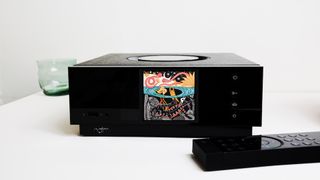How to build the Hi-Fi system of your dreams
The perfect Hi-Fi system awaits you

Building the perfect Hi-Fi system is the dream of audiophiles everywhere – and it’s not as unattainable as you might think.
These days, building the best Hi-Fi system for your needs doesn’t have to cost the world, or fill your entire home with annoying cables and bulky hardware; there are lots of options when it comes to choosing the best speakers, amplifiers, turntables, and music streamers for the space you have.
Many of these devices also come with modern conveniences like wireless connectivity, built-in voice assistants, and multi-room capabilities, which means your Hi-Fi system can be as modern (or as old school) as your heart desires.
However, before you go on a shopping spree, it’s important to understand all the different components that will make up your new Hi-Fi system, as well as having a rough idea of the features you want and a budget you’d like to stick to.
That’s why we’ve put together this handy guide on everything you need to know about building the Hi-Fi system you’ve been dreaming of ever since you bought your first record.
- The history of the turntable: how vinyl survived the CD, the iPod, and Spotify
- Do you have any of these rare records at home? They could make you filthy rich
- How does vinyl work and does it really sound better than streaming?
5 top buys for your new Hi-Fi system
Just looking for some quick hot buys? Before we go any further check out the five products below – all of which could make fantastic additions to your new Hi-Fi system.
The basics: what makes a Hi-Fi system?
According to the Sound Organization, there are three basic components that make up a Hi-Fi system: a source, amplification, and speakers.
Get daily insight, inspiration and deals in your inbox
Sign up for breaking news, reviews, opinion, top tech deals, and more.
Your source could be anything from a music streaming service played on your smartphone to a turntable – you could even use a CD player if you still have one.
An amplifier takes the weak electrical signal generated by your source, and powers it up enough to drive your speakers. It’s worth noting that many sources come with integrated amplifiers – even your smartphone contains a small amplifier, though using a separate DAC (Digital-to-Analogue Converter) improves the sound quality dramatically.
Lastly, there are the speakers. There’s lots of choice when it comes to this component, whether you’re looking for clever wireless speakers, powerful floor-standing speakers, or space-saving bookshelf speakers.

Setting your budget
Building a Hi-Fi system doesn’t have to be a huge drain on your bank account; sure, you could spend thousands, even millions on an enormous state-of-the-art setup, but there’s really no need.
At TechRadar, we have lots of guides to the bits of audio kit you might need to build your new Hi-Fi system.
Let's start with speakers; check out our guides to the best stereo speakers, best Bluetooth speakers, best smart speakers, best soundbars, and best wireless speakers. Listening solo? Check out the best headphones you can buy.
Need to buy a source? Read our guides to the best turntables, best TVs, best phones for music, and best laptops. If you are using a record player, be sure to check out our guide on how to set up a turntable.
If your audio source of choice doesn't have a built-in amplifier, you'll need to buy one – check out our amplifier reviews for more information, as well as the best portable DACs for boosting your smartphone's tinny sound.
If you are trying to limit the amount you spend, it’s a good idea to work out what kind of kit you might already have at home. As we mentioned, you could use a smartphone, laptop, or TV as your music source, which would work well with wireless speaker systems from the likes of Sonos, Bowers & Wilkins, and Harman Kardon.
Got a turntable knocking around in your attic? Check whether your record player has an integrated phono stage – if it does, you could save money on buying an external amplifier. Similarly, you can save money on an amplifier by purchasing an all-in-one music streamer like the Naim Uniti Atom – all you have to do is add some speakers, and you’re good to go.
Only have the budget for one speaker right now? Check out models that feature 360-degree grilles and disperse audio at all angles; the Amazon Echo Studio or the Sonos One are good places to start.
Whichever source-amplifier-speaker combination you opt for, be sure to set a realistic budget – and remember, you can always add components to your Hi-Fi system down the line, letting it grow with you over time.

Cables, stands, and other add-ons
If you do opt for a wired system, be sure to budget for cables; high quality cables can cost upwards of $40 / £40.
Similarly, you should consider whether you need to buy stands or wall-mounting kit for your speakers – again, these extras can quickly add up and it’s easy to forget to factor them into your budget.
For your source device and amplifier, consider whether you need to buy a stand or AV rack to keep everything neat and tidy; if you’re using a turntable as your source, make sure you have a sturdy, solid surface for it to sit on. You don’t necessarily have to buy new furniture for this – you can save money by repurposing what you already have.
Designing for your home
There’s no point in paying for some enormous floor-standing speakers if your space is small; similarly, a pair of tiddly bookshelf speakers probably won’t cut it if you’re building your Hi-Fi system in a big space.
Similarly, you need to think about the purpose of your Hi-Fi system. For example, if you want it to double up as a home cinema setup and are using your TV as your source device, you may want to invest in a soundbar that can be easily wall-mounted or placed on top of your TV stand.
The placement of your speakers is hugely important to the audio quality your Hi-Fi system will be able to achieve; ideally, stereo (left and right) speakers should be at least two meters apart, and tilted very slightly towards where you’re going to be sitting and enjoying your music.
While space constraints may leave you without much choice, try not to place your speakers in corners or too close to walls – this can cause the bass to muddy the other frequencies.
As well as saving money, buying integrated components – like a turntable with a built-in phonostage or an all-in-one music streamer – saves precious space when it’s at a premium.
Be sure to factor in any additional furniture that might take up space; stands and AV racks, for example.

Additional features to look for
These days, lots of the components that will make up your Hi-Fi system come with additional smart features like wireless connectivity, multi-room playback, and integrated voice assistants.
Let’s talk about wireless speakers to start with. Once upon a time, we might have discouraged you from relying on Bluetooth or Wi-Fi to connect your audio devices, but nowadays, the difference in quality between wireless and wired connectivity will only be discernible to the most expert of ears.
Wireless speaker systems from the likes of Sonos and Bowers & Wilkins are very convenient, eschewing annoying cables and instead relying on your home Wi-Fi network to communicate with each other. They can also be grouped into different zones so that you could have different systems for specific areas of your home.
These systems don’t come cheap though, and there’s no harm in looking at cheaper Bluetooth speakers, too. Check out brands like Ultimate Ears; speakers like the UE Boom 3 can be paired with each other for true stereo playback, without the need for cables. Bear in mind though, these smaller models won’t be as powerful as their bulkier counterparts.

Don’t forget that wireless connectivity isn’t just for your speakers; many source and amplification devices come with built-in Bluetooth or Wi-Fi connectivity, including turntables, music streamers, portable DACs, and CD players.
Aside from Wi-Fi and Bluetooth, other wireless connectivity methods like Google Chromecast and Apple AirPlay are worth looking out for, especially if you already have other devices that work within these brands’ ecosystems.
Another important consideration when it comes to choosing your source device is whether you want your Hi-Fi system to form part of your smart home. Many speakers come with built-in voice assistants like Amazon’s Alexa, Apple’s Siri, and Google Assistant, which means they can be used to control your other smart home devices – as well as being able to accommodate hands-free control.
Many source devices – including smartphones and smart TVs – come with voice assistants built in or at least work with them, too.
Lastly, and most importantly, you should consider how you want your new Hi-Fi system to sound, and look out for specific features that will help you achieve this. For example, if you’re planning to use your Hi-Fi system as a home cinema setup, you may want to look at speakers and soundbars that support immersive Dolby Atmos audio.
Also, if you’re going to be streaming primarily from Tidal or Qobuz – or playing your own Hi-Res Audio files – be sure that any wireless speakers support Hi-Res Audio streaming over Bluetooth or Wi-Fi.
Olivia was previously TechRadar's Senior Editor - Home Entertainment, covering everything from headphones to TVs. Based in London, she's a popular music graduate who worked in the music industry before finding her calling in journalism. She's previously been interviewed on BBC Radio 5 Live on the subject of multi-room audio, chaired panel discussions on diversity in music festival lineups, and her bylines include T3, Stereoboard, What to Watch, Top Ten Reviews, Creative Bloq, and Croco Magazine. Olivia now has a career in PR.













